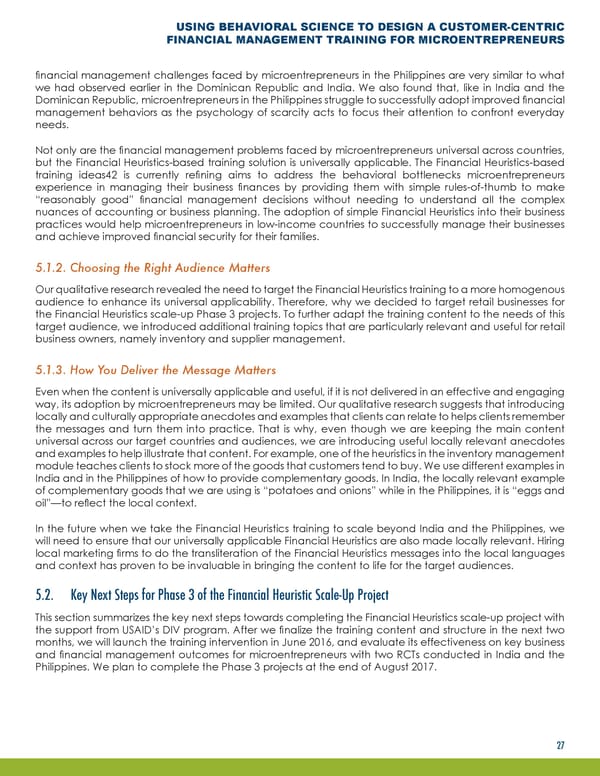USING BEHAVIORAL SCIENCE TO DESIGN A CUSTOMER-CENTRIC FINANCIAL MANAGEMENT TRAINING FOR MICROENTREPRENEURS financial management challenges faced by microentrepreneurs in the Philippines are very similar to what we had observed earlier in the Dominican Republic and India. We also found that, like in India and the Dominican Republic, microentrepreneurs in the Philippines struggle to successfully adopt improved financial management behaviors as the psychology of scarcity acts to focus their attention to confront everyday needs. Not only are the financial management problems faced by microentrepreneurs universal across countries, but the Financial Heuristics-based training solution is universally applicable. The Financial Heuristics-based training ideas42 is currently refining aims to address the behavioral bottlenecks microentrepreneurs experience in managing their business finances by providing them with simple rules-of-thumb to make “reasonably good” financial management decisions without needing to understand all the complex nuances of accounting or business planning. The adoption of simple Financial Heuristics into their business practices would help microentrepreneurs in low-income countries to successfully manage their businesses and achieve improved financial security for their families. 5.1.2. Choosing the Right Audience Matters Our qualitative research revealed the need to target the Financial Heuristics training to a more homogenous audience to enhance its universal applicability. Therefore, why we decided to target retail businesses for the Financial Heuristics scale-up Phase 3 projects. To further adapt the training content to the needs of this target audience, we introduced additional training topics that are particularly relevant and useful for retail business owners, namely inventory and supplier management. 5.1.3. How You Deliver the Message Matters Even when the content is universally applicable and useful, if it is not delivered in an effective and engaging way, its adoption by microentrepreneurs may be limited. Our qualitative research suggests that introducing locally and culturally appropriate anecdotes and examples that clients can relate to helps clients remember the messages and turn them into practice. That is why, even though we are keeping the main content universal across our target countries and audiences, we are introducing useful locally relevant anecdotes and examples to help illustrate that content. For example, one of the heuristics in the inventory management module teaches clients to stock more of the goods that customers tend to buy. We use different examples in India and in the Philippines of how to provide complementary goods. In India, the locally relevant example of complementary goods that we are using is “potatoes and onions” while in the Philippines, it is “eggs and oil”—to reflect the local context. In the future when we take the Financial Heuristics training to scale beyond India and the Philippines, we will need to ensure that our universally applicable Financial Heuristics are also made locally relevant. Hiring local marketing firms to do the transliteration of the Financial Heuristics messages into the local languages and context has proven to be invaluable in bringing the content to life for the target audiences. 5.2. Key Next Steps for Phase 3 of the Financial Heuristic Scale-Up Project This section summarizes the key next steps towards completing the Financial Heuristics scale-up project with the support from USAID’s DIV program. After we finalize the training content and structure in the next two months, we will launch the training intervention in June 2016, and evaluate its effectiveness on key business and financial management outcomes for microentrepreneurs with two RCTs conducted in India and the Philippines. We plan to complete the Phase 3 projects at the end of August 2017. 27
 Using Behavioral Science to Design a Customer-Centric Financial Management Training for Microentrepreneurs Page 29 Page 31
Using Behavioral Science to Design a Customer-Centric Financial Management Training for Microentrepreneurs Page 29 Page 31